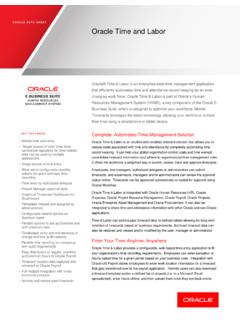Transcription of Thinking in Systems - six silberman
1 Thinking in SystemsTIS final pgs iTIS final pgs i5/2/09 10:37:345/2/09 10:37:34 Other Books by Donella H. Meadows:Harvesting One Hundredfold: Key Concepts and Case Studies in Environmental Education (1989).The Global Citizen (1991).with Dennis Meadows:Toward Global Equilibrium (1973).with Dennis Meadows and J rgen Randers:Beyond the Limits (1992).Limits to Growth: The 30-Year Update (2004).with Dennis Meadows, J rgen Randers, and William W. Behrens III:The Limits to Growth (1972).with Dennis Meadows, et al.:The Dynamics of Growth in a Finite World (1974).
2 With J. Richardson and G. Bruckmann:Groping in the Dark: The First Decade of Global Modeling (1982).with J. Robinson:The Electronic Oracle: Computer Models and Social Decisions (1985).TIS final pgs iiTIS final pgs ii5/2/09 10:37:345/2/09 10:37:34 LONDON STERLING, VAThinking in Systems A Primer Donella H. MeadowsEdited by Diana Wright,Sustainability InstituteTIS final pgs iiiTIS final pgs iii5/2/09 10:40:325/2/09 10:40:32 First published by Earthscan in the UK in 2009 Copyright 2008 by Sustainability rights reservedISBN: 978-1-84407-726-7 (pb)ISBN: 978-1-84407-725-0 (hb)Typeset by Peter Holm, Sterling Hill ProductionsCover design by Dan BramallFor a full list of publications please contact:EarthscanDunstan House14a St Cross StLondon, EC1N 8XA, UKTel: +44 (0)20 7841 1930 Fax: +44 (0)20 7242 1474 Email.
3 Quicksilver Drive, Sterling, VA 20166-2012, USAE arthscan publishes in association with the International Institute for Environment and DevelopmentA catalogue record for this book is available from the British LibraryLibrary of Congress Cataloging-in-Publication Data has been applied Earthscan we strive to minimize our environmental impacts and carbon footprint through reducing waste, recycling and offsetting our CO2 emissions, including those created through publication of this book. For more details of our environmental policy, see book was printed in the UK by TJ International Ltd, an ISO 14001 accredited company.
4 The paper used is FSC certifi ed. Part of this work has been adapted from an article originally published under the title Whole Earth Models and Systems in Coevolution Quarterly (Summer 1982). An early version of Chapter 6 appeared as Places to Intervene in a system in Whole Earth Review (Winter 1997) and later as an expanded paper published by the Sustainability Institute. Chapter 7, Living in a World of Systems , was originally published as Dancing with Systems in Whole Earth Review (Winter 2001).TIS final pgs ivTIS final pgs iv5/2/09 10:37:345/2/09 10:37:34 FOR DANA (1941 2001) and for all those who would learn from herTIS final pgs vTIS final pgs v5/2/09 10:37:345/2/09 10:37:34 TIS final pgs viTIS final pgs vi5/2/09 10:37:345/2/09 10:37:34 CONTENTS A Note from the Author | ix A Note from the Editor | xi Introduction: The Systems Lens | 1 Part One: system Structures and Behavior ONE.
5 The Basics | 11 TWO. A Brief Visit to the Systems Zoo | 35 Part Two: Systems and Us THREE. Why Systems Work So Well | 75 FOUR. Why Systems Surprise Us | 86 FIVE. system Traps .. and Opportunities | 111 Part Three: Creating Change in Systems and in Our Philosophy SIX. Leverage Points Places to Intervene in a system | 145 SEVEN. Living in a World of Systems | 166 Appendix system Defi nitions: A Glossary | 187 Summary of Systems Principles | 188 Springing the system Traps | 191 Places to Intervene in a system | 194 Guidelines for Living in a World of Systems | 194 Model Equations | 195 Notes | 204 Bibliography of Systems Resources | 208 Editor s Acknowledgments | 211 About the Author | 213 Index | 215 TIS final pgs viiTIS final pgs vii5/2/09 10.
6 37:345/2/09 10:37:34 TIS final pgs viiiTIS final pgs viii5/2/09 10:37:345/2/09 10:37:34A NOTE FROM THE AUTHORThis book has been distilled out of the wisdom of thirty years of Systems modeling and teaching carried out by dozens of creative people, most of them originally based at or infl uenced by the MIT system Dynamics group. Foremost among them is Jay Forrester, the founder of the group. My particular teachers (and students who have become my teachers) have been, in addition to Jay: Ed Roberts, Jack Pugh, Dennis Meadows, Hartmut Bossel, Barry Richmond, Peter Senge, John Sterman, and Peter Allen, but I have drawn here from the language, ideas, examples, quotes, books, and lore of a large intellectual community.
7 I express my admiration and grati-tude to all its also have drawn from thinkers in a variety of disciplines, who, as far as I know, never used a computer to simulate a system , but who are natu-ral Systems thinkers. They include Gregory Bateson, Kenneth Boulding, Herman Daly, Albert Einstein, Garrett Hardin, V clav Havel, Lewis Mumford, Gunnar Myrdal, Schumacher, a number of modern corpo-rate executives, and many anonymous sources of ancient wisdom, from Native Americans to the Sufi s of the Middle East.
8 Strange bedfellows, but Systems Thinking transcends disciplines and cultures and, when it is done right, it overarches history as spoken of transcendence, I need to acknowledge factionalism as well. Systems analysts use overarching concepts, but they have entirely human personalities, which means that they have formed many fractious schools of Systems thought. I have used the language and symbols of system dynamics here, the school in which I was taught. And I present only the core of Systems theory here, not the leading edge.
9 I don t deal with the most abstract theories and am interested in analysis only when I can see how it helps solve real prob-lems. When the abstract end of Systems theory does that, which I believe it will some day, another book will have to be , you should be warned that this book, like all books, is biased and incomplete. There is much, much more to Systems Thinking than is TIS final pgs ixTIS final pgs ix5/2/09 10:37:345/2/09 10:37:34X A NOTE FROM THE AUTHOR presented here, for you to discover if you are interested. One of my purposes is to make you interested.
10 Another of my purposes, the main one, is to give you a basic ability to understand and to deal with complex Systems , even if your formal Systems training begins and ends with this book. Donella Meadows, 1993 TIS final pgs xTIS final pgs x5/2/09 10:37:345/2/09 10:37:34A NOTE FROM THE EDITORIn 1993, Donella (Dana) Meadows completed a draft of the book you now hold. The manuscript was not published at the time , but circulated informally for years. Dana died quite unexpectedly in 2001 before she completed this book.





